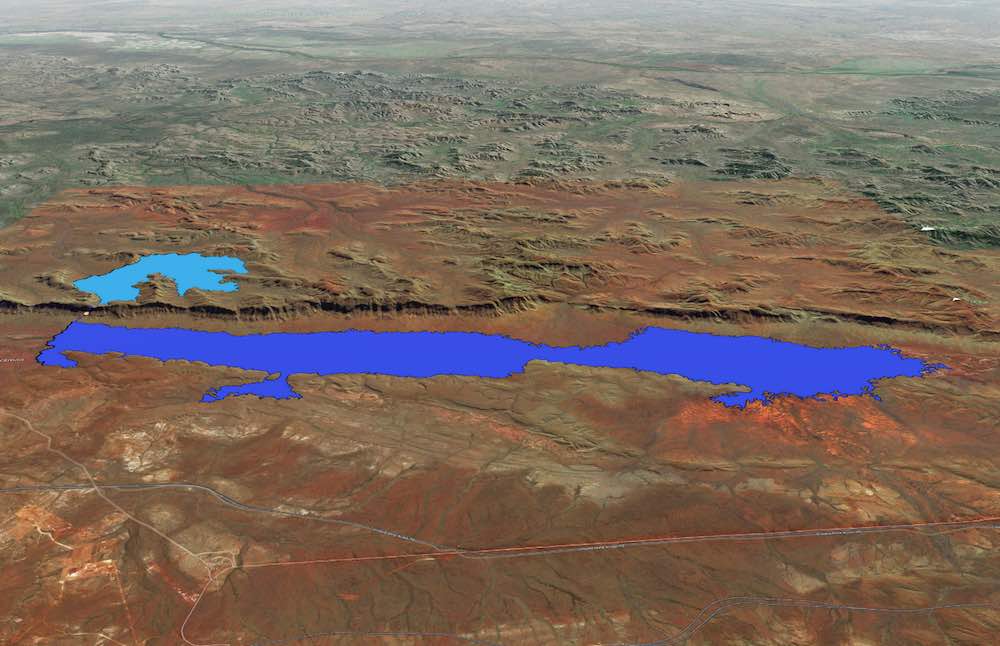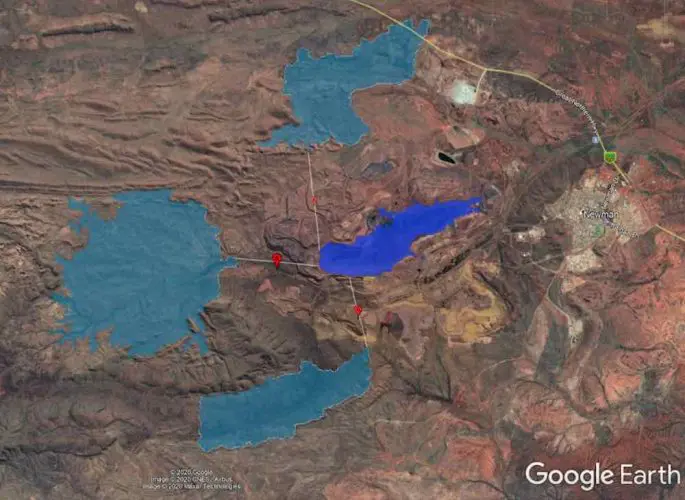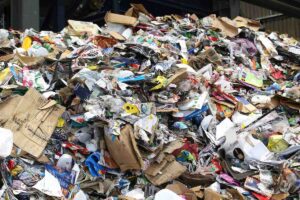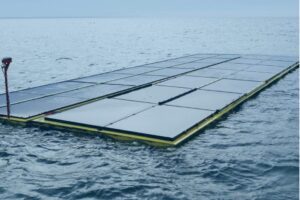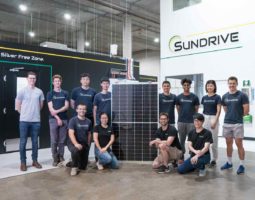Fortescue Metals Group has announced plans to build a 5.4 GW solar and wind project in the Pilbara, together with a nine gigawatt-hour (9GWh) battery. They should note that the Pilbara also has potential for very large scale off-river pumped hydro energy storage at relatively low cost.
Off-river pumped hydro energy storage works by pumping water from a lower reservoir uphill to a higher reservoir on sunny and windy days and letting the water flow back downhill through the turbines to the lower reservoir at night.
No rivers are needed – the water cycles up and down hill indefinitely. Pumped hydro is much cheaper than batteries for overnight storage.
The Pilbara covers an area of 0.5 million km2. Wind speeds are good, averaging 7-9 m/sec at 150m hub height across much of the region.
The solar resource is excellent, averaging more than six full sunshine hours per day with low seasonal variation. Average rainfall in the Pilbara is 250-500 mm per year, which is sufficient to initially fill and then maintain pumped hydro energy storages.
Mining and processing minerals using solar PV and wind requires large-scale storage of energy for 24/7 operation. For example, the Snowy 2.0 pumped hydro system has storage of 350GWh whereas the expanded Neoen big battery in South Australia is 0.2 GWh.
The ANU global pumped hydro Atlas can be used to visualise potential pumped hydro sites where both reservoirs need to be developed.
We searched the Pilbara for off-river pumped hydro storage opportunities and found seven large (50-150 GWh) and 25 intermediate (5-15 GWh) greenfield sites with combined storage potential of about 500 GWh. Some of the sites are close to existing mines (Table 1).
Table 1: Selected greenfield sites close to existing mines (explanation of parameters is here)
| Table 1:
Distance to nearest mine |
Cost class | Head (m) | Tunnel slope (%) | W/R ratio | Energy (GWh) | Power (GW) |
| 35km NW (Mt Newman) | D | 110 | 8 | 16 | 15 | 0.83 |
| 6km W (West Angelas) | D | 162 | 8 | 8 | 15 | 0.83 |
| 2km S (Wittenoom) | D | 190 | 8 | 6 | 15 | 0.83 |
| 1km (Turee Cr) | D | 210 | 5 | 7 | 15 | 0.83 |
| 15km SW (Tom Price) | C | 340 | 5 | 6 | 15 | 0.83 |
| 8km N (Brockman) | D | 140 | 16 | 10 | 150 | 8.3 |
| 8km N (Brockman) | D | 230 | 8 | 6 | 15 | 0.83 |
Figure 1: Pilbara greenfield sites
Defunct mine sites are possible locations for pumped hydro systems to service the Pilbara. There is an opportunity to shape a working mine to optimise it for pumped hydro at end of life. Such sites have the advantage of an existing lower reservoir (the pit) and are embedded in existing infrastructure.
However, mining pits have drawbacks. The conical shape of many pits means that the head (height difference between reservoirs) changes over a large range as water is drawn down, which can be problematic for the pump/turbine. Also, the head is often smaller than greenfield sites.
We conducted a survey of existing mining pits in the Pilbara. The combined storage potential that we identified at Newman, Tom Price and West Angelas is about 200GWh.
We used satellite imagery taken between 2000, and 2013, and hence, the survey includes mining pits as they existed 9-22 years ago. Data on each site is available in an accompanying spreadsheet. Visualisation is possible using Google Earth (the kml files are here). Clicking on a reservoir or connector brings up a pop-up data sheet.
Figure 2: 150 GWh options at Newman. The dark blue region is the Whaleback pit (lower reservoir)
This work is supported by the Australian government through ARENA. Responsibility for the views, information or advice expressed herein is not accepted by the Australian government.
Andrew Blakers is the Australian National University lead for the Australian Centre for Advanced PV.

